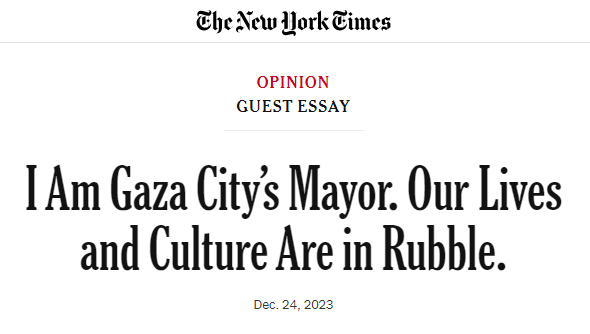The New York Times is famously sensitive about publishing opinion pieces by personalities or on subjects that might “trigger” the progressive sensibilities of its own staff.
Writing in The Economist, former New York Times opinion editor James Bennet explained how publishing a piece from Republican senator Tom Cotton in June 2020 was enough to cause a crisis and for Bennet to lose his job, as New York Times staffers took to Twitter to express their outrage.
While some elected right-wing US politicians are evidently persona non grata on the opinion page, unelected members of Palestinian terrorist organizations don’t cause quite the same level of disgust, if any, among the esteemed staff at The New York Times.
Perhaps it was the stealthy way in which this op-ed by Yahya R. Sarraj was presented:

According to the accompanying bio, “Dr. Sarraj is the mayor of Gaza City and a former rector of the University College of Applied Sciences there. He wrote from Gaza City.”
It all sounds credible and above board. After all, isn’t Sarraj a mayor in the same way that Eric Adams is the mayor of New York?
Actually, no.
It’s several paragraphs before Sarraj mentions the following:
One of my major goals after the Hamas administration appointed me mayor in 2019 was to improve the city’s seafront and foster the opening of small businesses along it to create jobs.
Hamas appointed him mayor, something that caused some controversy in 2019 among Palestinians given that the last time Gaza held municipal elections was in 2005.
Nobody gets to reach the lofty heights of Gaza City’s mayor unless they have the intimate trust of Gaza’s terrorist rulers. And given how Hamas controls the messaging coming out of Gaza, it’s most likely that Sarraj would have cleared his New York Times op-ed with the Hamas authorities before submitting it.
Perhaps that’s why there is no mention of the seminal event that sparked this war — the Hamas massacre of October 7. Instead, what Sarraj describes as the “unrelenting destruction of Gaza — its iconic symbols, its beautiful seafront, its libraries and archives and whatever economic prosperity it had,” is simply the result of an “Israeli invasion” and “bombardment.”
Having been subjected to many years of hearing that Gaza is an impoverished “open-air prison,” New York Times readers may have been surprised to see Sarraj describe how Israel has “pulverized” Gaza’s “cultural riches and municipal institutions”:
The Gaza Zoo has been destroyed, with many of its animals killed or starved to death, including wolves, hyenas, birds and rare foxes. Other casualties include the city’s main public library, the Children’s Happiness Center, the municipal building and its archive, and the seventh-century Great Omari Mosque. Israeli forces have also damaged or destroyed streets, squares, mosques, churches and parks.
The Mayor’s Expertise
It’s worth noting that Sarraj is an associate professor of transportation. His LinkedIn profile states that he has “very good experience in management as well as engineering” and is a “specialist with a good experience record in infrastructure, road design, traffic analysis, traffic management and environmental impact analysis.”
He has a first degree in civil engineering, a second degree in Transport Planning and Engineering, and a PhD in Traffic Management.
Is it even possible that Gaza City’s mayor, an engineer by training, was unaware of the miles of Hamas tunnels underneath his city or the terrorist infrastructure embedded in the civilian population?
Indeed, in 2022, a misfired Islamic Jihad rocket fell on Jabaliya killing two civilians. According to the IDF, the location from which the missile was fired was owned by the Gaza City municipality, headed by Sarraj.
“Sarraj chose to take care of the terrorist organization Islamic Jihad more than the residents of the city he heads, and abused public space which belongs to the residents of the city for terror. This is how he harmed his citizens directly,” the IDF Spokesperson’s Unit said.
‘Why can’t we live in peace?’
Sarraj concludes his opinion piece with a question that assumes an astonishing level of gullibility on the part of readers:
Why can’t we live in peace and have open borders and free trade?
Sarraj should ask the people who appointed him as mayor. They should be able to explain to him how many Israelis would die as a result of open borders that would allow Hamas terrorists to enter Israel at will. They would readily admit that free trade would allow an influx of weapons to carry out October 7 massacres “again and again,” as Hamas official Ghazi Hamed boasted.
Hamas Official Ghazi Hamad: We Will Repeat the October 7 Attack Time and Again Until Israel Is Annihilated; We Are Victims – Everything We Do Is Justified #Hamas #Gaza #Palestinians pic.twitter.com/kXu3U0BtAP
— MEMRI (@MEMRIReports) November 1, 2023
Sarraj is in no position to talk about peace. As demonstrated by Israel’s military ground operation, Gaza City has operated as a Hamas terrorist base all within plain sight of its mayor.
The New York Times is perfectly within its rights to give a platform to ordinary Palestinians suffering as a result of Hamas’ decision to launch a war against Israel. But giving a platform to a Hamas-appointed figure without giving its readership the full picture is one step too far.
Liked this article? Follow HonestReporting on Twitter, Facebook, Instagram and TikTok to see even more posts and videos debunking news bias and smears, as well as other content explaining what’s really going on in Israel and the region.


